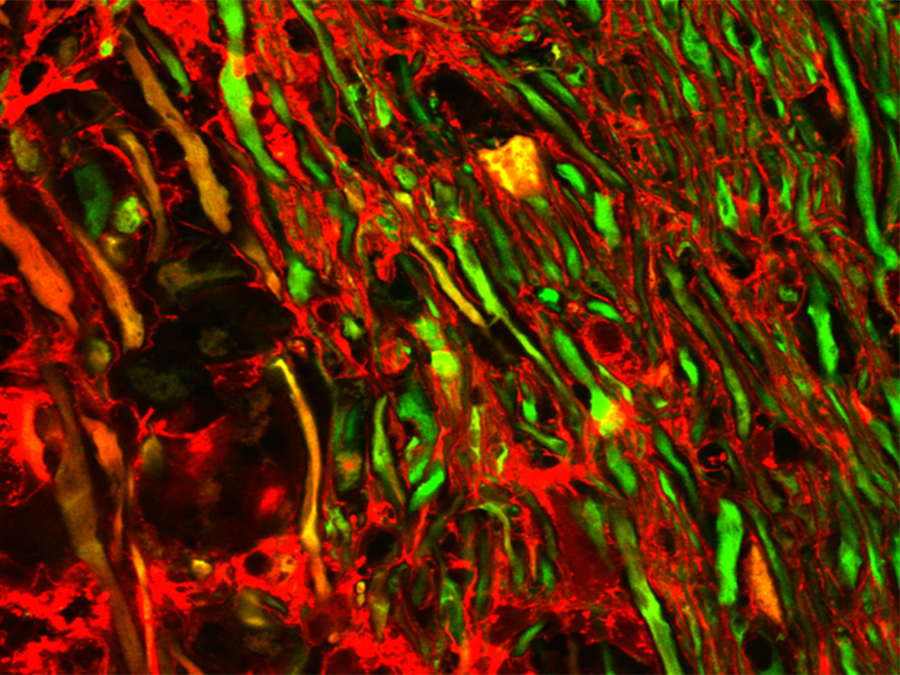Multiple sclerosis: Degeneration of long nerve fibers due to influx of calcium ions
Perilous ruptures

In Germany alone, more than 200,000 patients suffer from multiple sclerosis (MS). MS is an autoimmune condition and one of the most common inflammatory diseases of the central nervous system. The degree of the patient´s disability, is critically dependent on the extent of nerve-fiber loss. This is because the autoimmune reaction characteristic of the condition attacks the long processes, called axons, which are responsible for the transmission of nerve impulses. Now a team led by Prof. Thomas Misgeld of the Institute for Neuronal Cell Biology at TUM and Prof. Martin Kerschensteiner, Director of the Institute of Clinical Neuroimmunology at LMU, has investigated this process in a new study working with an animal model of MS. The scientists published their results in the academic journal Neuron.
Calcium amount determines fate of axons
In previous studies, Kerschensteiner, Misgeld and colleagues had observed that axons in inflammatory lesions often were swollen and subsequently fragmented. “But in some cases, the swelling spontaneously regressed and these axons recovered,” says Martin Kerschensteiner. “So the process is in principle reversible, and could perhaps be therapeutically modulated if we had a better understanding of the underlying mechanisms.”
With the aid of in-vivo microscopy, the researchers have now shown in an animal model of MS that the fate of these axons depends on their calcium content. Axons with an abnormally high concentration of calcium are more likely to undergo swelling and subsequent degeneration and less likely to recover from this state than axons with normal levels of the ion. “Strikingly, these changes begin relatively early in the course of the axon damage process,” says Thomas Misgeld. Indeed, in ten percent of the axons examined, the calcium concentration was already increased prior to the onset of swelling. In converse, about half of the swollen axons were found to have high levels of intracellular calcium, and a correspondingly high risk of degeneration.
Membrane ruptures are the portal of entry for calcium ions
The excess calcium is derived from the extracellular space and it enters the axon via nanoruptures in the cell membrane, as the team was able to demonstrate using a fluorescent dye coupled to a macromolecule. The complex is too large to penetrate into an intact axon. Only if the membrane has been damaged can it be taken up into the axon and detected by its fluorescence. "With the aid of in-vivo microscopy, we were also able to show that many of the axons that take up the dye also contain increased amounts of calcium,” says Martin Kerschensteiner.
“The fact that, in the inflamed nervous system, tears in the cell membrane can contribute to the death of nerve fibers is a new discovery, which could in future be therapeutically relevant.” adds Thomas Misgeld. It is already known from studies of spinal cord injury that nerve cells have the capacity to repair ruptures caused by mechanical forces. The researchers therefore hope that a better understanding of the origins and repair of damaged nerve-cell membranes will bring them closer to identifying new targets for therapeutic interventions.
PubliCation:
Witte et al., Calcium influx through plasma-membrane nanoruptures drives axon degeneration in a model of multiple sclerosis, Neuron, January 24, 2019, DOI: 10.1016/j.neuron.2018.12.023 (Open Access).
MOre Information:
Prof. Thomas Misgeld and Prof. Martin Kerschensteiner are members of the Cluster of Excellence „SyNergy – Munich Cluster for Systems Neurology“, which receives funding in the forthcoming Excellence Initiative.
- Profile of Prof. Thomas Misgeld
- Website of the Institute for Neuronal Cell Biology
- Website of the SyNergy-Cluster
Contact
Prof. Thomas Misgeld
Institute for Neuronal Cell Biology
Technical University of Munich
Tel.: +49 (0)89 - 4140-3512
thomas.misgeld@tum.de
Technical University of Munich
Corporate Communications Center
- Dr. Vera Siegler
- vera.siegler@tum.de
- presse@tum.de
- Teamwebsite